Japanese nuclear repository in Primorye or the place of dismantlement of submarines of the Pacific Fleet
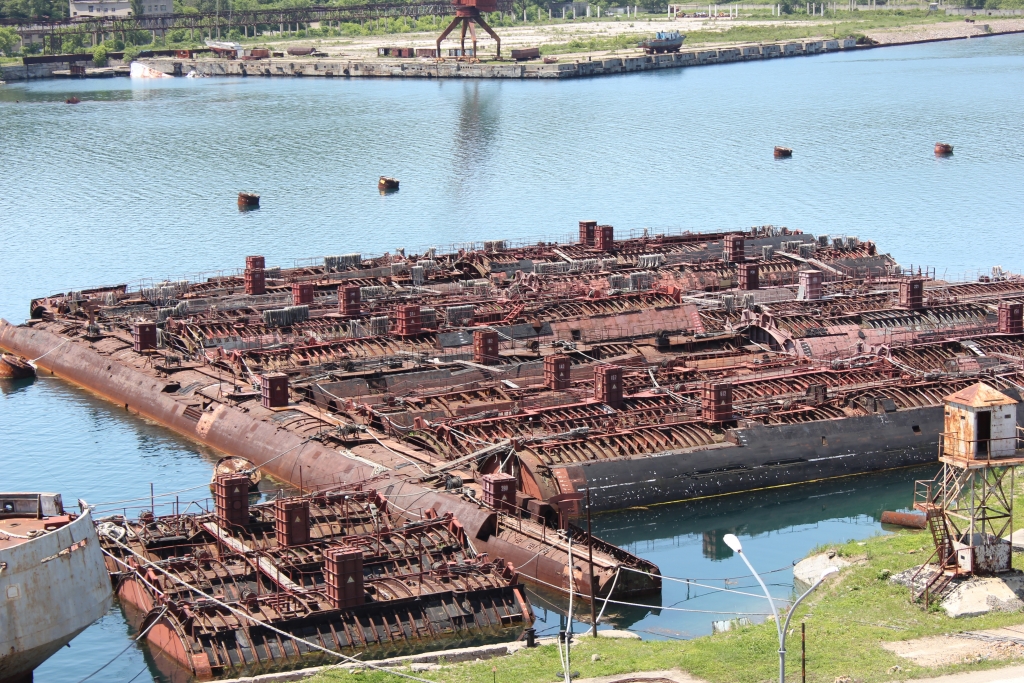
Radioactive waste in Primorye. Photo source.
At the beginning of the year, a petition “Prevent a nuclear repository in Primorye!” Appeared on the portal Change.org and in just 2 weeks collected more than 70 thousand signatures.
The reason for this petition, various media materials and even several rallies in Primorye, was the publication of Medvedev’s order No. 3009-p of December 29, 2018 , giving Rosatom good to prepare for the signing of a Russian-Japanese agreement on cooperation in the construction of a regional air-conditioning center long-term storage of radioactive waste in Primorsky Krai.
Let's try to figure out what is really meant by a nuclear burial ground, is there any radioactive waste in Primorye and what does Japan have to do with it. And at the same time we will look at how the nuclear submarines of the Pacific Fleet are being disposed of.
1. "DalRAO"
Firstly, radioactive waste (RW) in the Far East has long existed and is not at all Japanese, but ours, domestic. And their source is the Pacific Fleet of the USSR and Russia (Pacific Fleet), or rather its atomic component - the spent nuclear submarines (APL). For 2018, at least 82 of them have already been written off . At the same time, about 250 nuclear submarines and surface nuclear ships were built in the USSR, of which more than 200 are currently decommissioned and dismantled. In addition to nuclear submarines, the technical maintenance vessels of these boats, several decommissioned surface ships with nuclear power plants, as well as ground infrastructure in the form of several bases, can be attributed to radioactive waste sources.
Two such coastal technical bases in the Far East - in Vilyuchinsk in Kamchatka and in Fokino in Primorye in 1998 were transferred from the Ministry of Defense to Minatom, as a more specialized organization in the field of radioactive waste management. In 2000, the base was transformed into an enterprise of the Federal State Unitary Enterprise "DalRAO". At that time, almost all of these objects were in emergency condition, had radioactive contamination of the soil, and solid waste was stored on open-air sites. In 2011, DalRAO, in the form of two departments, formed the Far Eastern Branch of RosRAO , a Rosatom structure centrally involved in the management of radioactive waste throughout the country.
The network of branches and offices of "RosRAO" covers the whole country and even goes beyond it. We have many sources of waste, respectively, and there are many enterprises dealing with them. And this is not counting facilities for the reprocessing of spent nuclear fuel (Type of "Mayak"), which are not included in "RosRAO".
Like the Far Eastern branch, the RosRAO also has a north-western center in the Murmansk Region (SevRAO) on the basis of three bases dealing with the elimination of the nuclear fleet of the Northern Fleet. By the way, it is two times more Pacific, but now it is not about him.
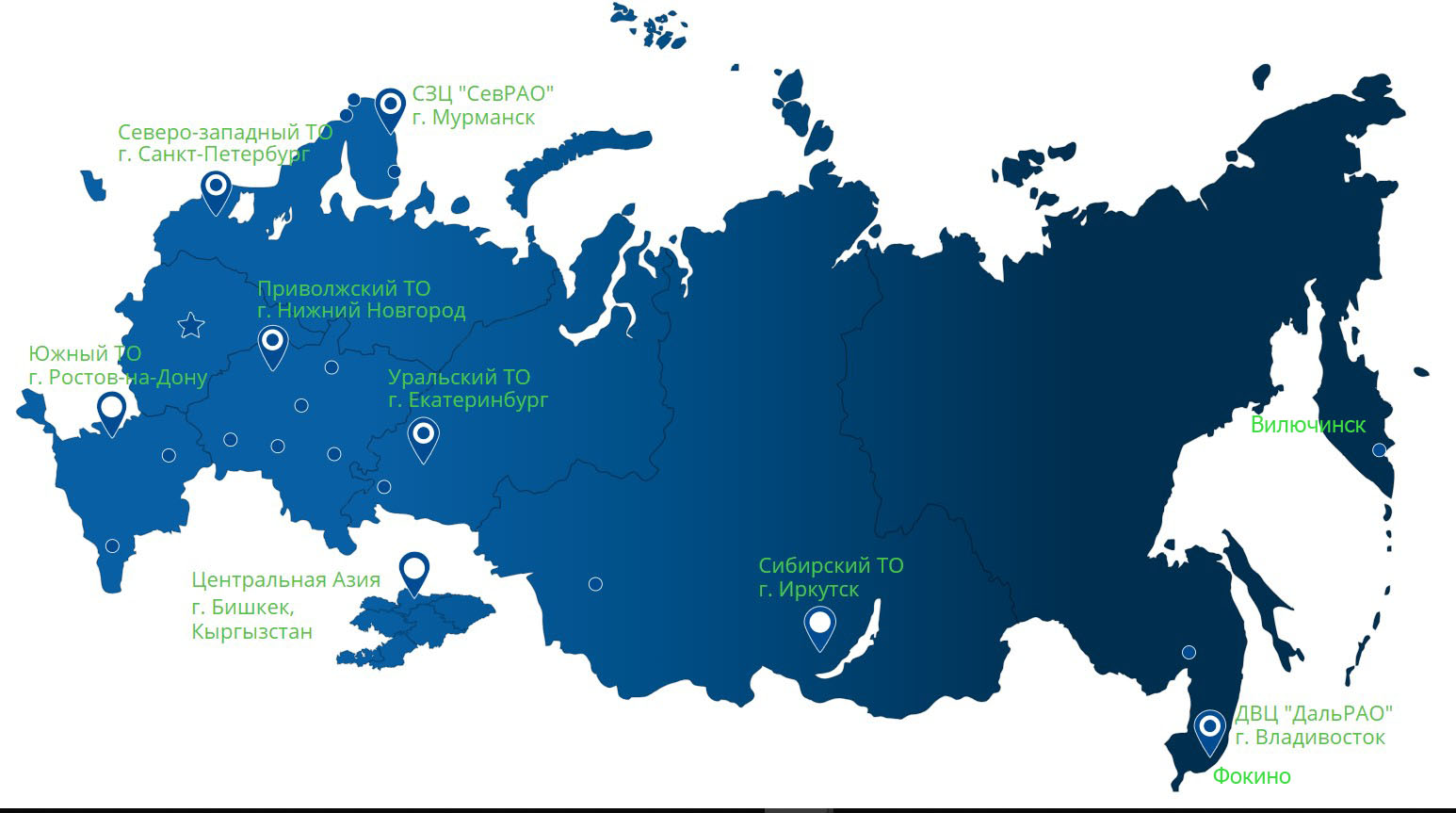
The network of branches and branches of "RosRAO", modified by me. Source )
The main works of “DalRAO” are carried out in Primorye, in the closed city of Fokino, 40 km from Vladivostok. Since the 1960s, since the first appearance of nuclear submarines in the Pacific Fleet, they have been dealing with spent nuclear fuel, solid and liquid radioactive waste formed during the operation of nuclear submarines, and now with their decommissioning. By the way, since 2014, not anybody has been appointed director of DalRAO, but the former commander-in-chief of the Pacific Fleet Konstantin Sidenko .
Fokino district is surrounded by numerous bays where industrial sites are located, military bases, shipyards, including the largest factory of the Pacific Fleet “Zvezda” in Bolshoy Kamen , where Russia’s largest 500-meter dry dock is being built for the construction of the largest in the world.atomic icebreaker project "Leader" . But this is a topic for a separate post.
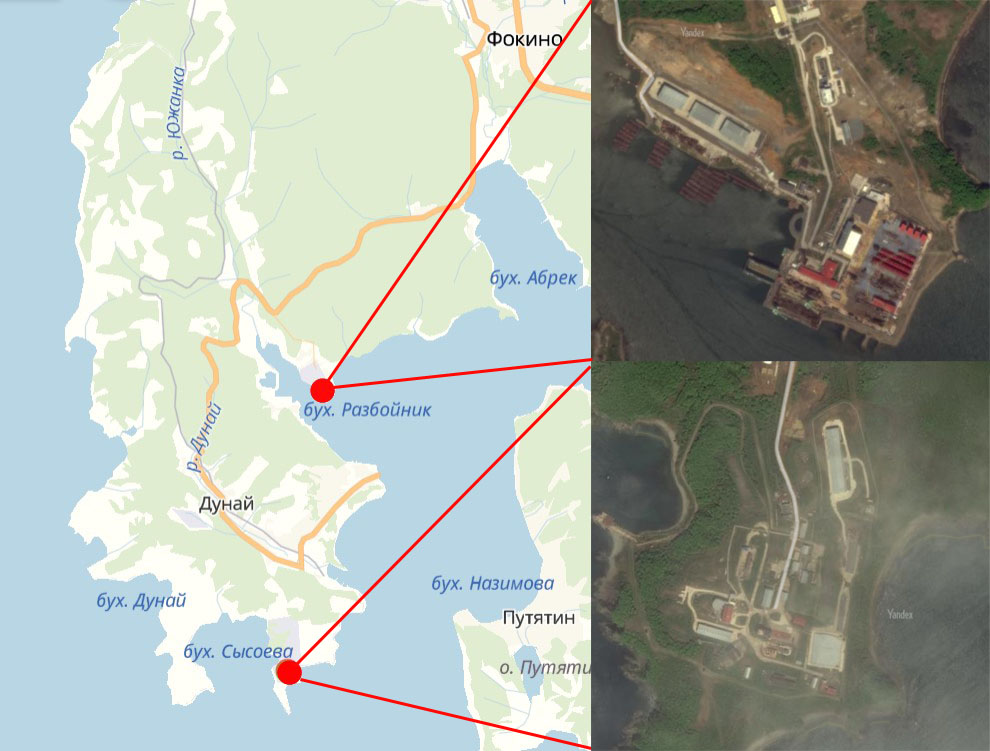
Two industrial sites of the Fokino branch - in Sysoev Bay and Razboynik Bay.
2. Dismantlement of nuclear submarines and work with RW
First, let's look at the process of dismantling submarines. First, it is beautiful. And secondly, it will be clear from him what they are doing in Fokino and what is the role of Japan here. Below is shown the NPS dismantling scheme adopted in Russia, which is being implemented both in the North and in Primorye as the necessary infrastructure becomes available.
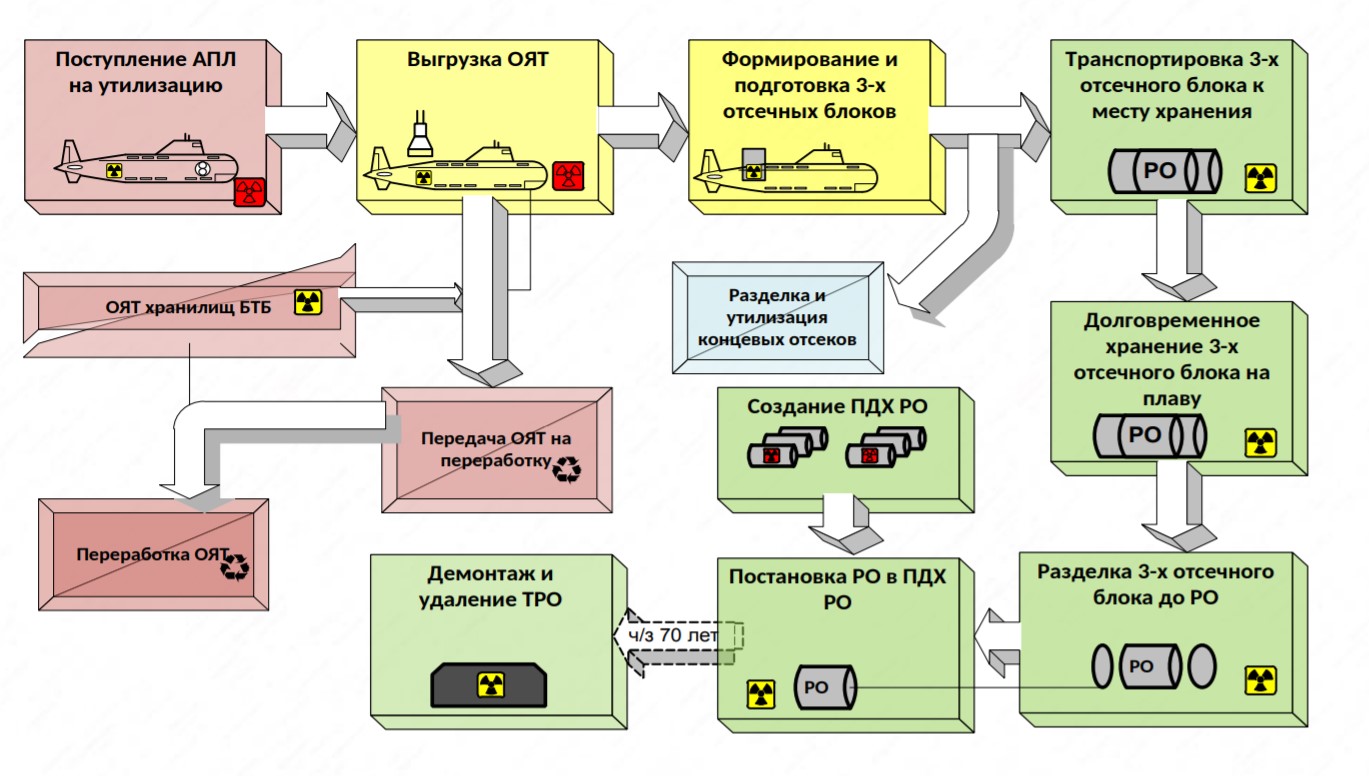
Block diagram of the disposal of nuclear submarines in Russia. Taken from a presentation from the meeting of the Federation Council on the development of the Northern Sea Route in Murmansk in September 2018 , where the author was present.
Visually, the implementation of this scheme in Fokino can be viewed in a small video “RosRAO”:
First of all, decommissioned nuclear submarines unload spent nuclear fuel (SNF). To date, this operation has been carried out on all decommissioned submarines at DalRAO. And by 2014, all accumulated SNF was finally transported by 43 echelons for reprocessing outside the Primorsky Territory - to the Mayak plant in the Chelyabinsk Region.
Then the recyclable boat is sent to the already mentioned Zvezda plant in the Big Stone , where it is manually cut - the reactor compartment and two adjacent ones are cut out of it, which act as floats. They are sealed, and thus receive three-compartment reactor units, which are kept afloat in Razboinik Bay for at least several years, and sometimes dozens, from Soviet times. The remaining parts of the boat are disposed of as non-radioactive scrap metal.

Point of temporary storage of three-compartment blocks in the Razboinik bay. Photo: Anton Balashov, PrimaMedia
At the same time, Razboynik Bay will store reactor compartments from other bases and shelters of submarines of the Pacific Fleet in the Far East for storage in the Far East for storage for further disposal. In particular, in 2017, in the course of a unique operation, 12 three-compartment reactor units from Kamchatka were delivered to Razboin Bay with the help of the semi-submersible vessel "Transhelf".
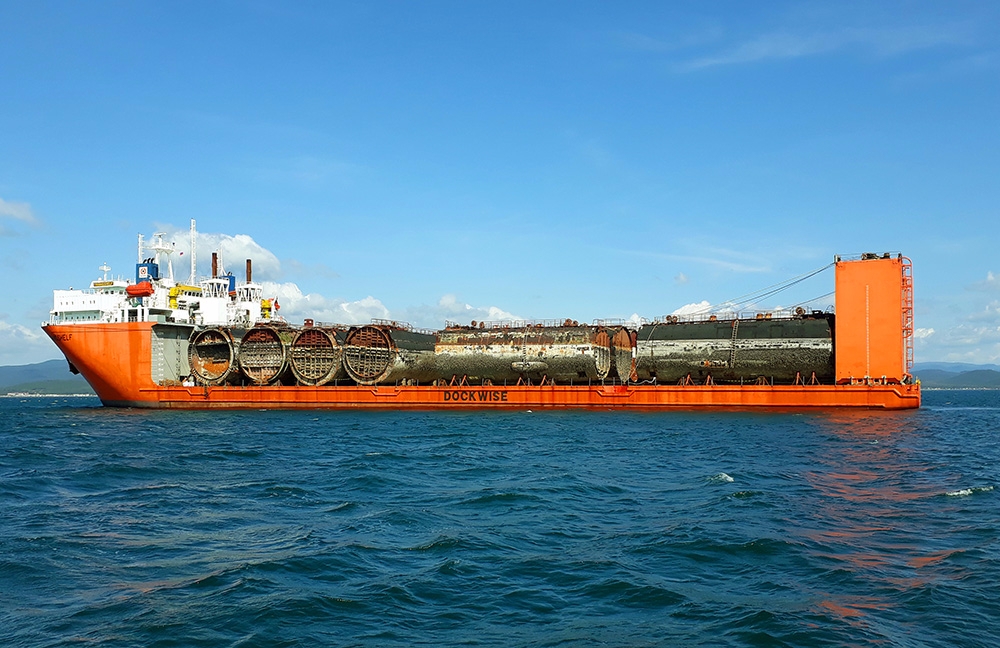
The Transshelf ship delivers 12 reactor compartments from Kamchatka to Primorye. Photo by Primamedia
In 2012, with the help of Japan, a long-term storage facility for reactor compartments (PAHRO) was equipped on land. Similar to PDHRO in SZTS "SevRAO"in the Murmansk region with the money of Germany built in Sayda-Guba. After aging, the three-compartment blocks are lifted from the water to the shore using the floating dock “Sakura”, and “extra” side blocks are cut off at the stocks and the base is welded to be placed on land.
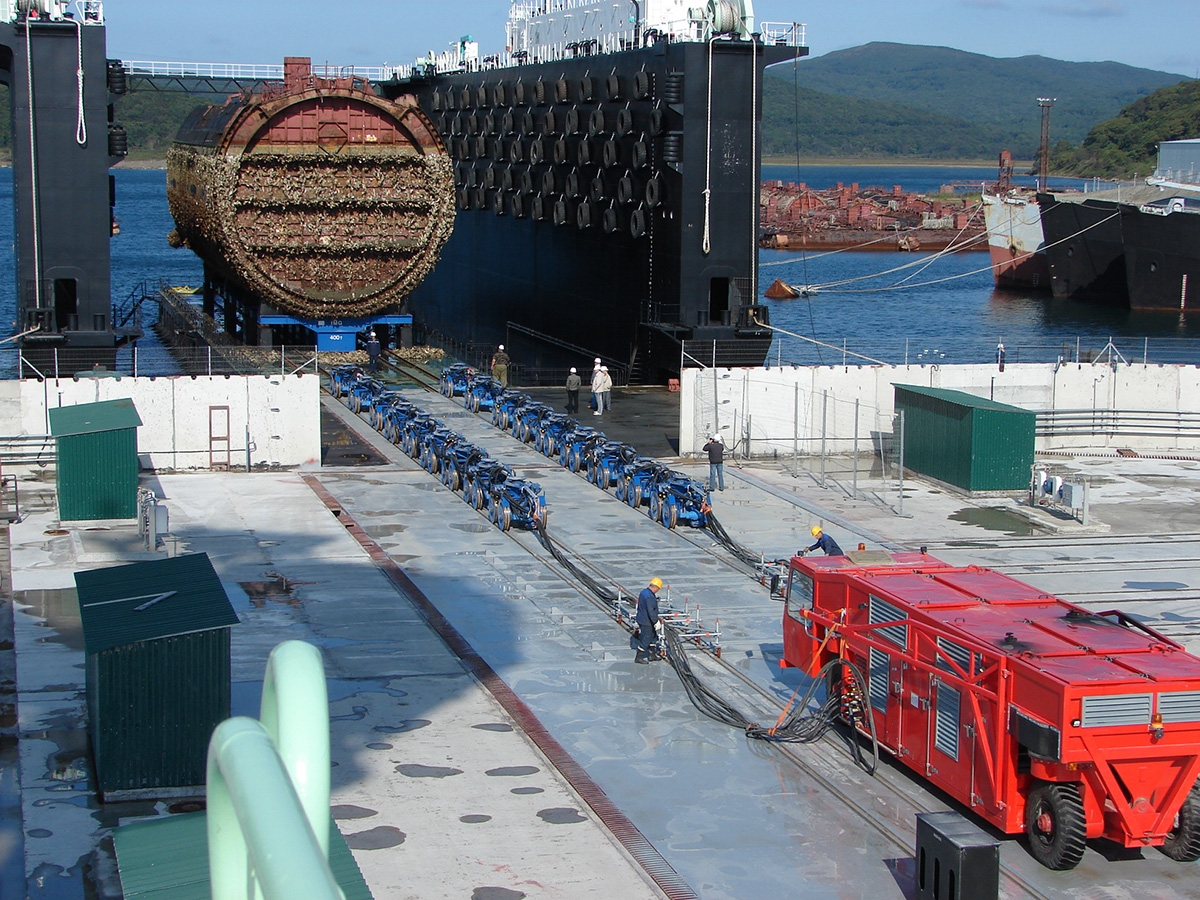
Lifting the three-compartment block to the building berth for further cutting.
Then the block is moved to the cleaning and painting shop, also supplied by the Japanese. The reactor compartment is cleaned of shell and rust, covered with three layers of special protective paint.
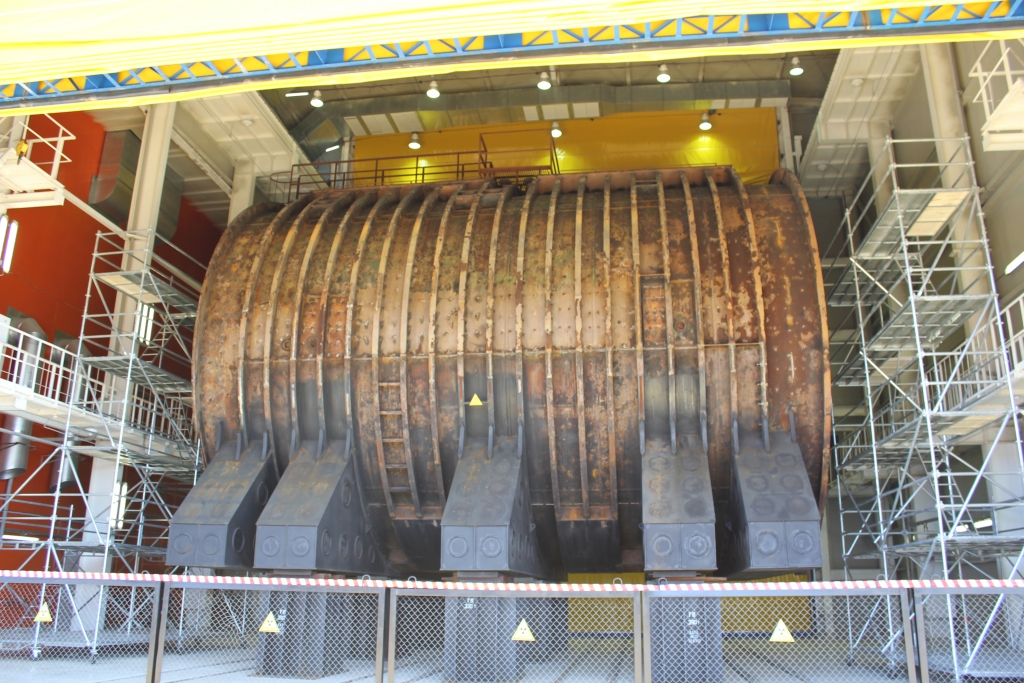
Shop cleaning and painting. Photo: Shkodin Vadim, RIA PrimaMedia
Next, the compartments are placed on a special open area of PDHRO, where they will spend about 70 years to reduce activity. After this period, it will be possible to start dismantling the unit and disposing of reactors.

Since 2014, the reactor compartments have been located at the long-term storage facility of the reactor compartments (RHMP) on land. Photo: Photo: Alexander Khitrov, RIA PrimaMedia
Now 43 single-compartment nuclear submarine reactor units are placed in storage at PDHRO . In addition to the nuclear submarine reactor units, the unit also houses the packaging of nuclear technology service vessels and the reactor compartments of the electronic reconnaissance ship Urals SSV-33 , the largest surface ship with a nuclear power plant built in the USSR. Now it is written off and is on recycling.
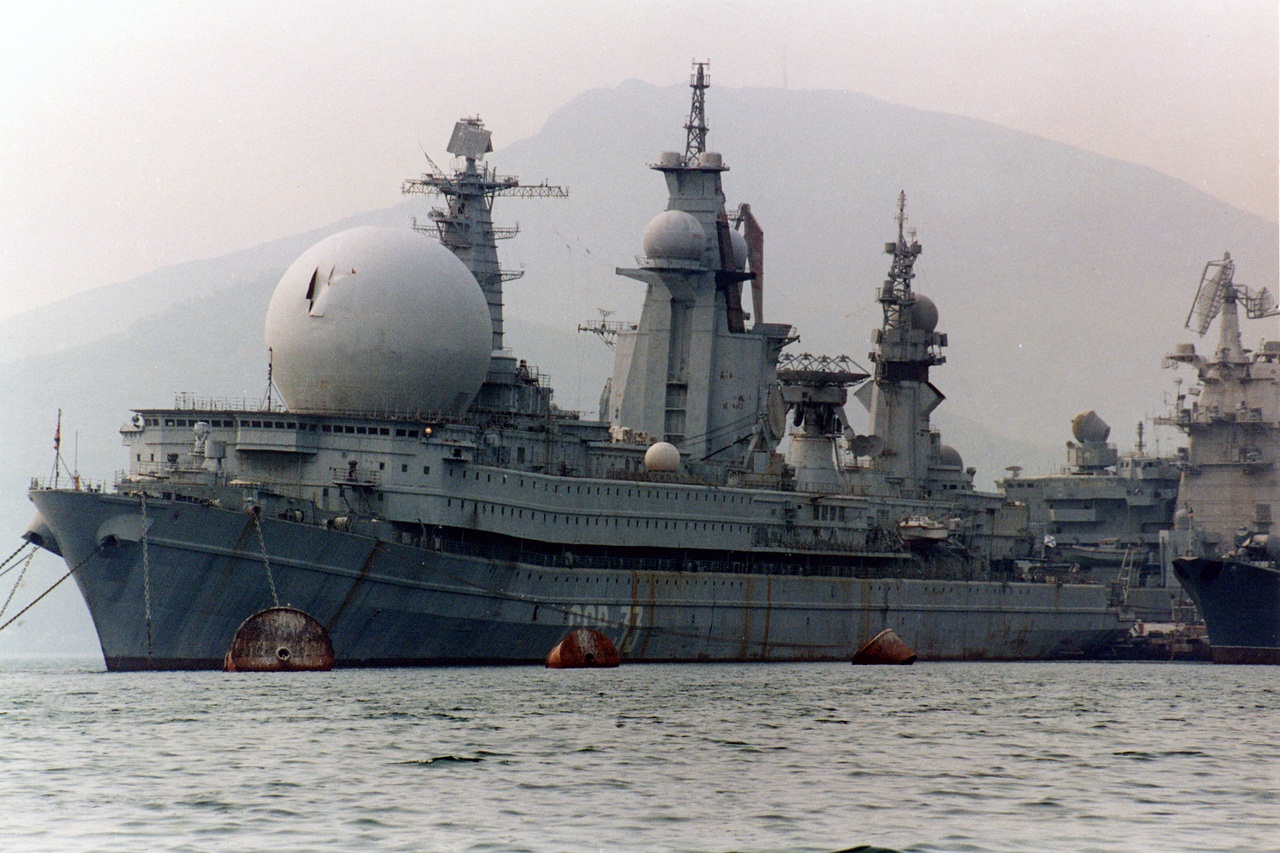
CER-33 "Ural". Photo source .
The second industrial site of Fokino is located 5 km to the south, on Cape Naumova in Sysoev Bay. Here was the unloading of spent nuclear fuel of nuclear submarines, its storage before being sent for reprocessing, as well as the storage of other radioactive waste, both liquid and solid, generated during the maintenance of nuclear submarines. In addition, the recovered radioactive soil from the liquidation of the consequences of the accident in 1985 in the Chazhma bay is stored right there .
Since 2001, the site has been sorted, packed in containers and placed for temporary storage of more than 12.5 thousand cubic meters. meters of SRW taken from the Navy. Rehabilitation of 16.5 thousand square meters of territories contaminated with radioactive substances has been completed - the entire territory of the former coastal technical base.
In addition, as in the main center for radioactive waste management in the Far East, in Sysoev Bay there istemporary storage of radioisotope thermoelectric generators (RTGs) , where 157 RTGs are collected from the entire region and from the Eastern part of the Northern Sea Route - autonomous power sources for naval facilities, meteorological stations and navigation equipment.
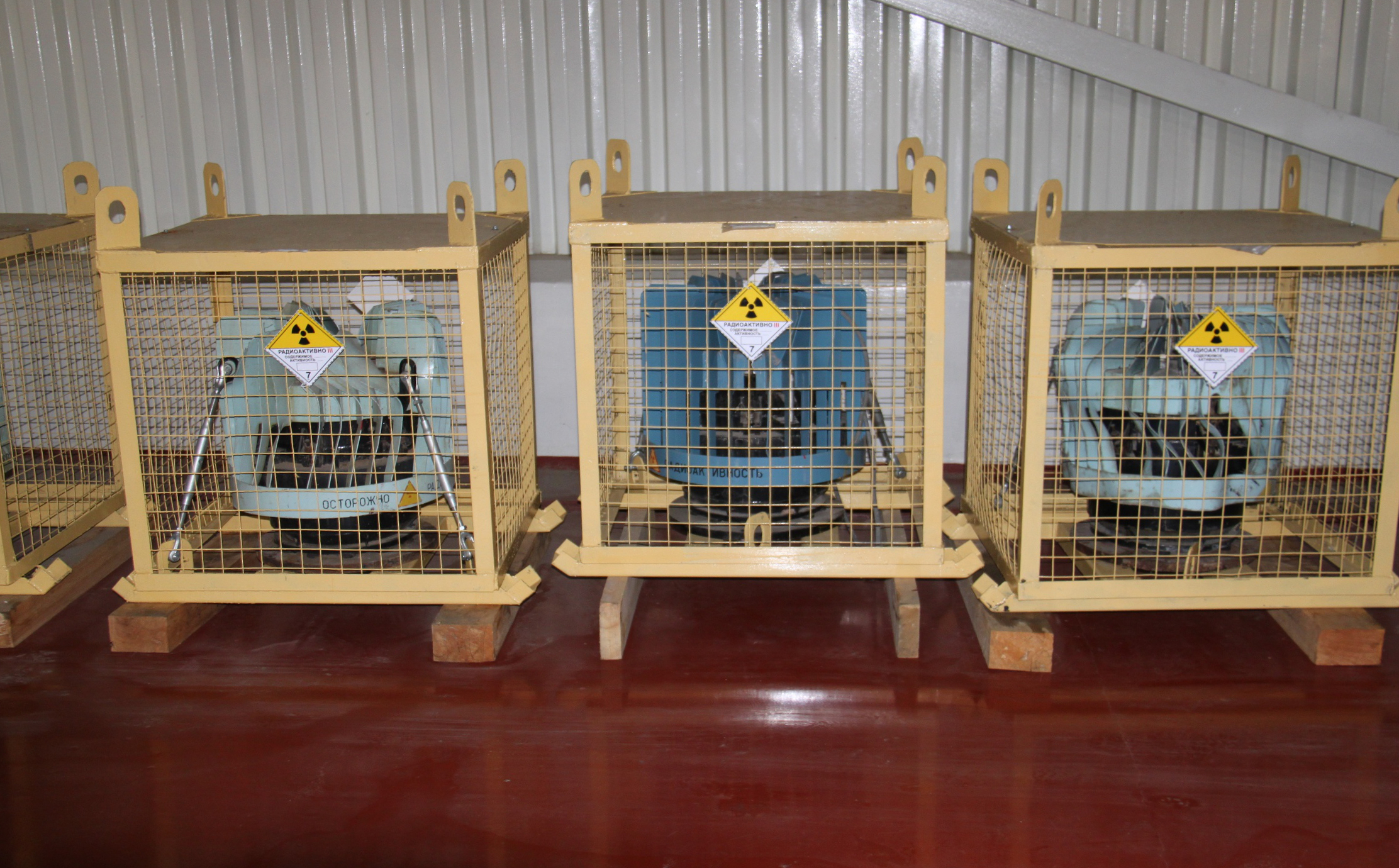
RTGs in temporary storage in Sysoev Bay Source.
Also on the site in 2004, a complex for processing liquid radioactive waste (LRW) was created.
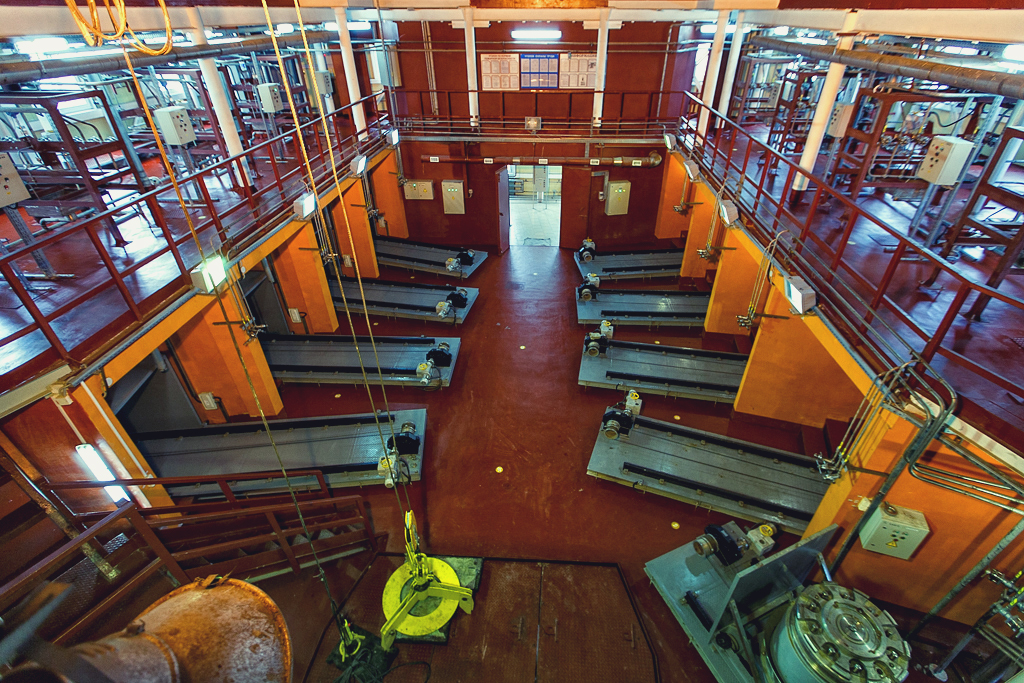
Complex for processing liquid radioactive waste in Sysoev Bay based on ion-selective sorption. Another photo and its description on the link
Here it is necessary to make a small lyrical digression. The topic of LRW reprocessing is quite interesting, since I myself work in an organization that develops technologies for cleaning LRW. The above installation of LRW processing is a matter of pride of “DalRAO”, since the sorbent incorporated in the installation was developed in Primorye, at the Institute of Chemistry, Far Eastern Branch of the Russian Academy of Sciences. Without detracting from the merits of my colleagues, I’ll note that an article was recently published by employees of the Far Eastern Federal University and the Pacific Oceanological Institute of the Far East Branch of the Russian Academy of Sciences.who investigated the sorbent of our production, checked with it the content of radioactive cesium in the waters of the Sea of Japan and recommended its use in the liquid radioactive waste cleaning installation of JSC “DVZ Zvezda”, i.e. apparently in the installation "Lily of the Valley", which is slightly lower. But so far we have not started working with the Far Easterners) The end of the lyrical digression.
3. Regional Center for Conditioning and Long-Term Storage of Radioactive Waste in Primorsky Krai
Most of the repositories of radioactive waste in Fokino, built during the Soviet era, are already full and their quality leaves much to be desired.
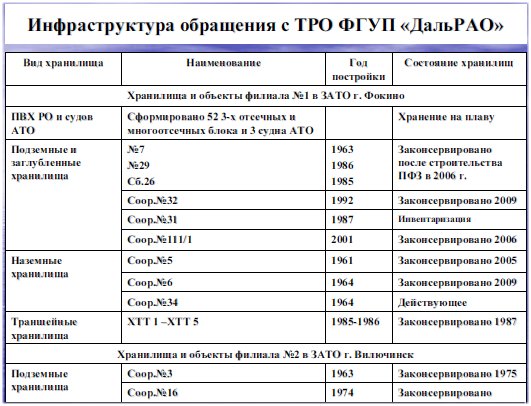
Infrastructure of radioactive waste storage facilities in Fokino. Source .
Therefore, it is precisely on Cape Naumov in Sysoev Bay that the construction of a regional center for radioactive waste began in 2018 (the tender for 589 million rubles was won by Federal Center for Science and High Technologies Special Scientific-Production Association Eleron ), around which passions flared up and a petition began.
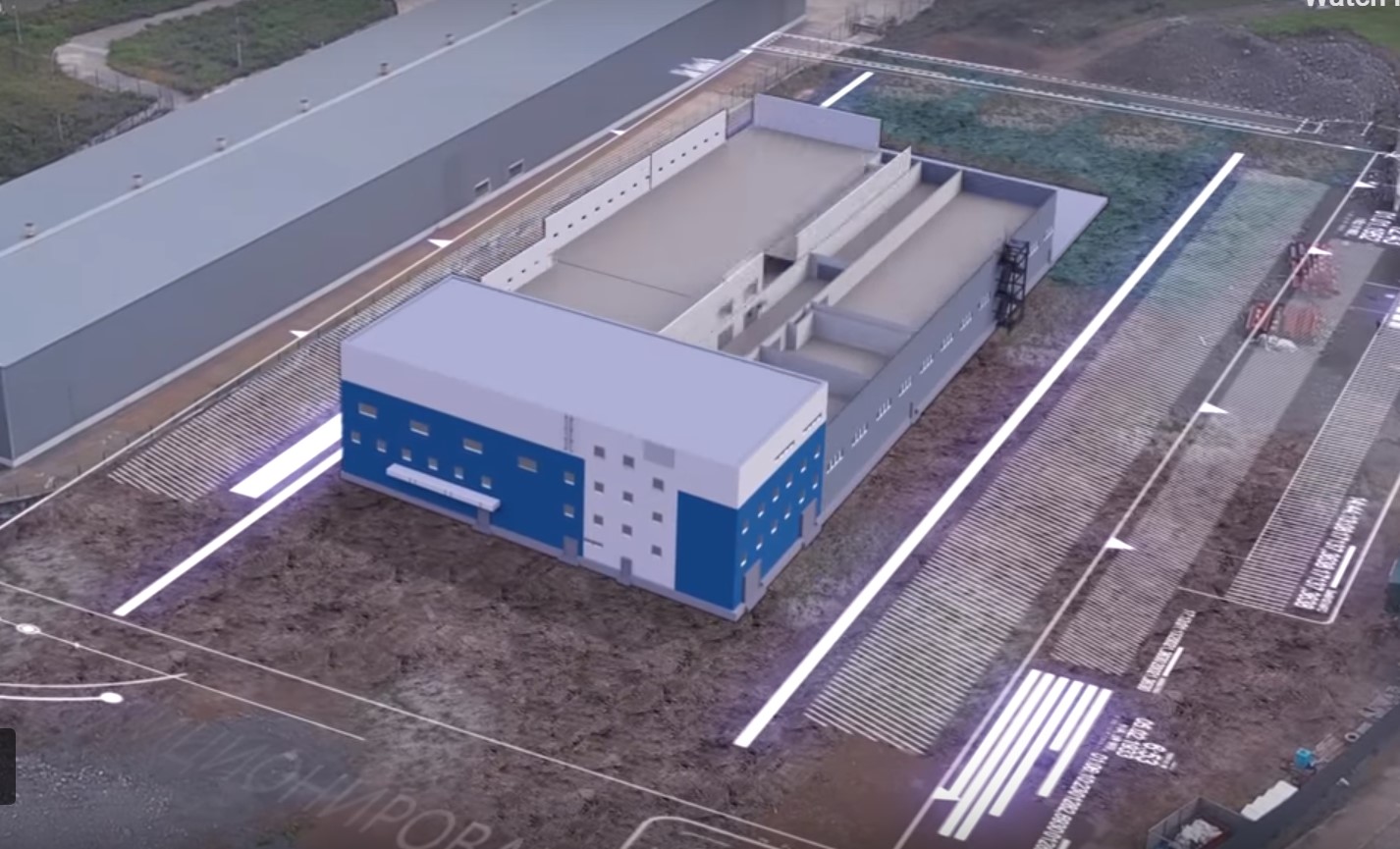
Render of the Regional Center for the Conditioning and Long-Term Storage of Radioactive Waste in the Primorsky Territory from the “RosRAO” roller .
At the same time, the project of the Regional Center of RAO, passed public discussion,The hearing took place in March 2017 . According to the materials of the hearings ( EIA materials ), it is planned to build new storage facilities: a storage facility for conditioned radioactive waste with a useful volume of 500 cubic meters. m (400 cubic meters for low level waste (LLW), 70 cubic meters for intermediate level waste (NAO) and 30 cubic meters for high level waste (HLW); storage point for very low level radioactive waste (VLLW), 1000 cubic meters with possibility of expanding up to 4000 cubic meters, and also in the future two more storage facilities for VLLW, with a volume of 4000 and 800 cubic meters.
Total, the maximum amount of RW in new storage facilities can reach 8800 cubic meters, of which Medium and high level - no more than 100 cubic meters.
At the modern technological level, the center should bring RW to a safe state - reduce the volume by pressing or transferring liquid waste into solid waste, and pack it into modern reliable containers for RW. This is called conditioning.
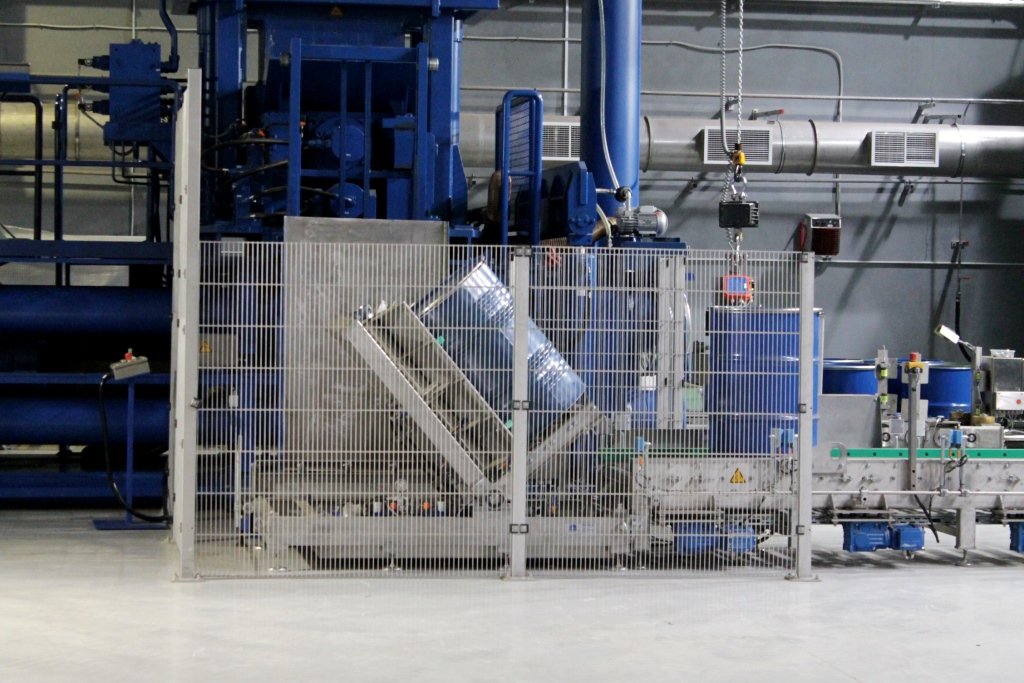
Installation of pressing solid RW at a similar complex of RW conditioning in SZTs SevRAO. A source.
By the way, since the dismantlement of nuclear submarines in the Northern Fleet, in SZTS SevRAO, goes faster in some parameters than in Pacific Ocean, and the center for conditioning of radioactive waste has been operating there since 2017 , journalists from Primorye are sometimes taken there to show how it will be . But people are still scared of the news and sign the petition.
It is stated that after repacking the waste, theirwill be removed from Primorye for final disposal at the operating and opening disposal sites of the National Operator for RW Management . This is another structure of the “RosRAO” type, but not dealing with waste management, but its final disposal.
But this is not yet accurate, since the repositories of the National Operator, and those that are only being built (in Tomsk and Mayak), are the only things that are already working (In Novouralsk, Sverdlovsk Region) are quite far from Primorye, and they are also designed for medium and low-level 3rd and 4th grade wastes.
And at the end of last year, the director of DalRAO, Sidenko, stated that: now the company is preparing to launch a first and second waste treatment facilityhazard classes. It is planned that the waste will be processed, compressed and packaged in containers for the purpose of export outside the Primorye Territory for transfer to the national operator.
The 1st and 2nd classes of radioactive waste are the most active waste for which the new Center has a storage capacity of no more than 100 m3.
Therefore, I would not expect that all radioactive waste will be removed from Primorye, taking into account their large volume. It is more likely that the most active RW will be taken out, although it is difficult to say when this happens, because the National Operator does not yet have storage facilities for 1st and 2nd class RW. And thousands of 3rd and 4th grade waste will most likely remain in Fokino.
But I wouldn’t have been worried about this in the Primorye’s place, since all the same, as long as there are nuclear submarines in the Pacific Fleet, radioactive waste will be formed there and they will work with them in Fokino.
4. Well, where does Japan come from? And will their waste be imported?
Work on the elimination of the nuclear legacy of the Navy with the active participation of not only Russia, which cleans its territory, but also of other states. And this is understandable. After all, with the collapse of the USSR and the end of the Cold War, the loss of control and the degradation of the levels of protection of military facilities threatens the whole world. Any accident at a nuclear facility or nuclear submarine sludge (and Russia got about 200 from the USSR), leakage from a repository of radioactive waste or liquid radioactive waste threatens to be an environmental catastrophe if not for the entire world ocean, then for its closest neighbors for sure. Therefore, it is perfectly normal that developed countries are ready to help invest in eliminating the threats left over from the Cold War. Well, and besides, it gives the possibility of inspections of the money spent, which is important in a situation of gradual controlled disarmament.
Therefore, in the distant 2002 political realities, the G8 leaders established the Global Partnership against the Spread of Weapons of Mass Destruction and Related Materials. The leaders of Russia, the USA, Great Britain, Canada, Japan, Germany, Italy, France agreed to allocate about 20 billion euros for these purposes for 10 years. Later, another two dozen countries joined the Global Partnership. More information about the participants, their contributions and spending can be read on the website of the Ministry of Foreign Affairs .

G8 Summit on June 27, 2002 in Kananaskis, Canada.
As a result, by 2014, Russia received about $ 2 billion each for chemical disarmament and nuclear submarine dismantlement, in parallel as part of federal target programs (for example, such as “Industrial disposal of weapons and military equipment of the nuclear complex for 2011-2015 and for the period up to 2020 "And" Ensuring nuclear and radiation safety for 2008 and for the period up to 2015 "(NRS-1) , and then the FTP NRS-2 ) by investing the same amount on their own.
In addition to Russia, Germany, Italy, France, as well as the neighboring Scandinavian countries, were significantly invested in the construction of specific facilities for the elimination of the Northern Fleet’s heritage in the Murmansk and Arkhangelsk regions.
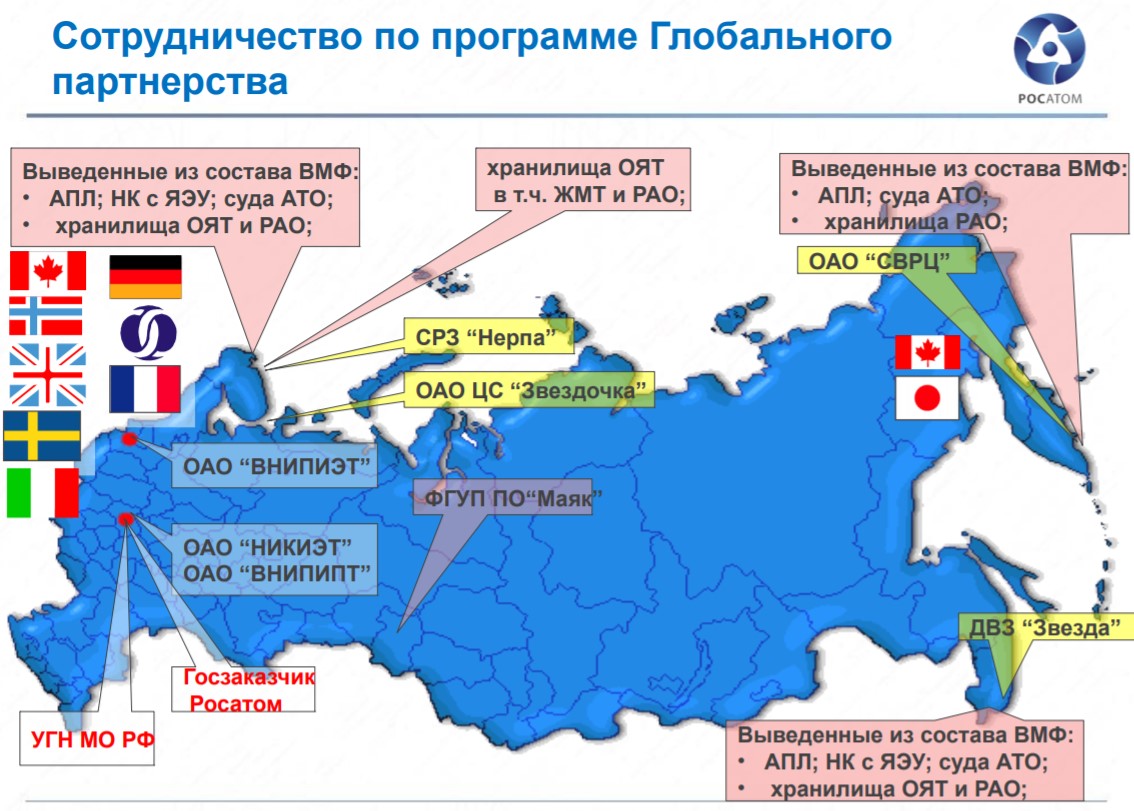
Work geography and financial donors in the Global Partnership on the territory of the Russian Federation. Source .
For obvious reasons, Japan, Canada and the United States invested more in eliminating threats to the nuclear heritage in the Far East. Moreover, Japan did this even before the creation of a large Global Partnership, helping to eliminate nuclear legacy in the countries of the former USSR - Russia, Ukraine, Belarus. The entire list of works funded by Japan can be found here . Specifically for the Far East and Primorye, Japan delivered the following:
1. 1994-2001. A floating complex for the processing of liquid radioactive waste "Suzuran" (translated from the Japanese - "Landysh") was built at our shipyards with Japanese money (about $ 45 million). Japan was particularly interested in it in order to prevent the release of radioactive waste into the Sea of Japan. Alas, until the early 1990s, the practice of dumping liquid radioactive waste “under screw” was completely normal for our nuclear fleet. Lily of the valley allowed to prevent such a discharge and overflow of LRW storage.
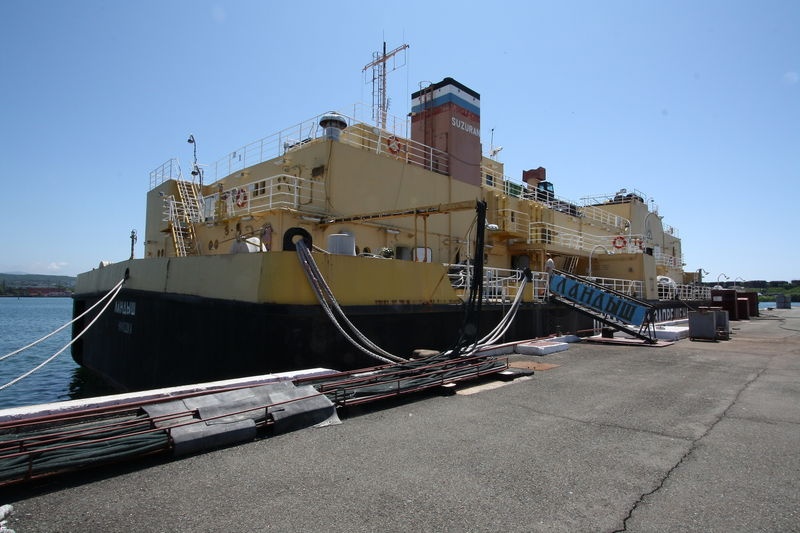
“Suzuran” (“Lily of the Valley”). Photo source .
2. 2003-2009 Japan, with a small contribution from Australia, South Korea and New Zealand, allocated $ 65 million , partially financed the dismantlement of 6 submarines.
3. 2010-2012. Japan allocates (about $ 55 million)for equipping a long-term storage facility for nuclear submarine compartments in Razboynik Bay: building and transferring to Russia the Sakura floating dock, two gantry cranes with a lifting capacity of 10 and 32 tons, and the Sumire tug.

The float "Sakura" allows you to raise not only the submarine compartments ashore, but also to dispose of nuclear maintenance vessels. Source .
4. 2013-2014. For 7 million dollars the construction of a reactor compartment cleaning and painting plant shown above
And now Japan is going to allocate about 18 million dollars (1.16 billion rubles) for the purchase of equipment for the Regional Center for Conditioning and Long-Term Storage of Radioactive Waste in Primorsky Krai ( source )
5. Instead of conclusion
- No nuclear repository of Japan in Primorye is planned. Rather, there will be a radioactive storage facility and a center for the treatment of our own radioactive waste.
- No radwaste from abroad will not be brought into Primorye. Also because it is prohibited by our environmental legislation . Although there are exceptions in terms of SFAs, but this is a separate story and does not concern the facility in Primorye.
- RW in Primorye can be transported from other regions of the Russian Federation - from the locations of nuclear submarines of the Pacific Fleet, but for the purpose of their disposal and, in general, improving the environmental situation in the country. As long as we have a nuclear submarine, there will be RW.
- The Japanese are great, as are the other members of the Global Partnership. It is good that there are such international projects.
- Rosatom and Russia are great too, because did most of the work on our budget money with you as part of federal targeted programs.
